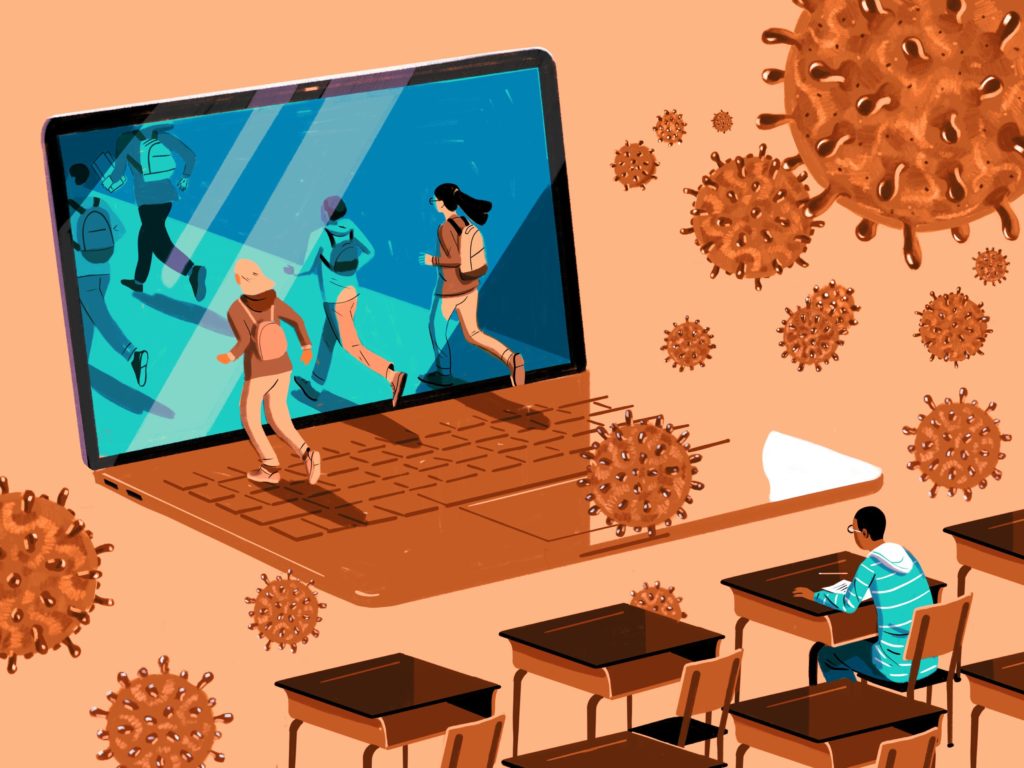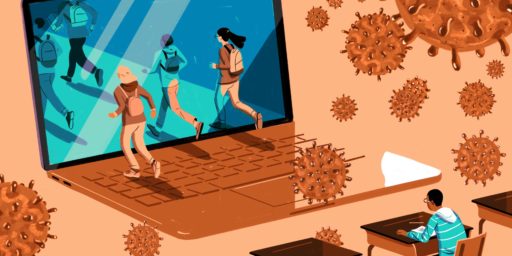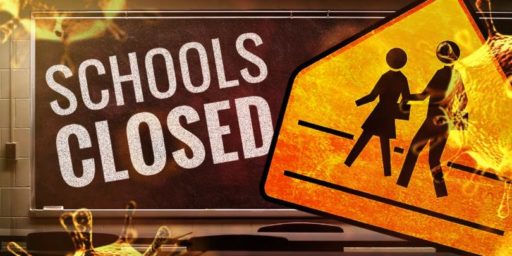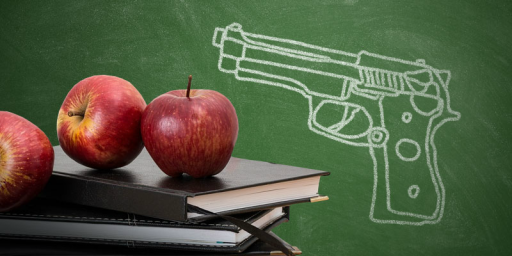Schools Under Pressure to Re-open
Until our kids go back to school, we can't go back to work.

WaPo (“Under pressure to reopen this fall, school leaders plot unprecedented changes“):
From the White House podium to harried homes, pressure is building to reopen the nation’s schools. But the next iteration of American education will look far different from the classrooms students and teachers abruptly departed last month.
Many overwhelmed school systems remain focused on running remote education that was set up on the fly. Others, though, are deep into planning for what they see coming: an in-between scenario in which schools are open but children are spread out in places where they are normally packed together.
The new landscape could include one-way hallways, kids and teachers in masks, and lunch inside classrooms instead of cafeterias. Buses may run half empty, and students may have their temperatures read before entering the building. And in districts all over the country, officials are considering bringing half the students to school on certain days, with the rest learning from home. Then they would swap.
“Our students need some kind of normalcy,” said Michael Hinojosa, superintendent of the Dallas Independent School District. “Right now, their whole world has been disrupted with things that they’ve never dealt with before, and they need to be around other people.”
Many teachers are scared of going back too early, and teachers unions are cautioning against it. Health experts warn that even if covid-19 cases abate, a second wave of infection could arrive with flu season later this year. And while many parents are eager to end the national experiment in remote education, others are terrified that any return to school would expose their children to a deadly disease.
But President Trump has pressed to reopen the economy, and one key to a functioning workforce is a school system that allows parents to do their jobs. Conservative activists have protested stay-at-home orders in several states, with Trump’s encouragement. Several states are starting to reopen some businesses, with more planned in May.
Many educators, too, are eager to get students back, having concluded that remote education is far less effective and may leave lasting academic damage. They also fear for the safety and well-being of students who rely on schools for food, health care, social services and emotional stability.
Like it or not, our schools serve as a de facto national daycare program. They’re also a social support network for children from abusive and under-resourced homes.
Those of us fortunate enough to be able to do our jobs remotely are almost certainly less efficient given that we’re now doing double-duty as teacher assistants and lunchroom workers. Those who can’t work from home are having to risk their kids’ health by putting them into daycare—in a system without anything like the excess capacity to handle this many more kids, let alone do so with social distancing.
The upshot of all of this is that we really can’t open the economy until we re-open the schools. While kids are seemingly more resistant to the virus than those of us over 50, there are a lot of kids with underlying conditions.
The options, they are not good.






Gee, it’s almost like affordable daycare isn’t a luxury after all, but is actually a foundational element of our economy …
I’ve always tended toward optimism, or at least a kind of cheerful fatalism, but it’s getting harder and harder to see any good outcome to all this.
This is the dangerous point. Up to now the Bleach Drinkers have been saying the opposite of what sane governors and health officials are saying. Now we are entering a time when the messages might appear to be congruent. It’s important that the sane people don’t lose control to the crazies.
We’re a month to 6 weeks till the end of the school year. We should keep the schools closed, regroup over the summer and figure out how to safely open in September. Most likely schools will need to pick up instruction where they were when the March closing occurred. Anecdotal evidence suggests that many students, particularly younger ones, have not progressed much since the schools have closed.
I suspect social distancing will be part of any reopening, which leads to the question of how will that be paid for? Fewer students per class will require more classrooms and additional teachers, in a period of budget contraction due to falling tax revenue and balanced budget mandates. Typical legislative response to revenue shortfalls is to layoff teachers and enlarge class sizes.
The truth is we don’t really know this. Children gets sick all the time to the point most parents won’t seek medical help unless it’s “serious”. A feverish or puking child is considered more normal whereas the same in adults provokes more concern. The average parent, especially one that’s on Child #2 or more, will give them Pedialyte or soup/crackers but may not think too much about it.
My friend has two children under the age of eight, one with cerebral palsy. Both became really sick earlier in the month but it was dismissed since “kids don’t get COVID”. It wasn’t until her husband (an essential worker with daily public contact) came down with the same symptoms that she freaked and got him tested – guess what? Her logic was the boys always get high fevers when sick but they weren’t “too high” and that vomiting isn’t a typical symptom. Keyword here is “typical” – somebody’s always going to get the outlier symptoms.
How many children aren’t being diagnosed since it could be another childhood illness and kids are germ factories? We just know it’s not killing them in droves; we have no idea what the infection rate is and what that means for their future health. Blood clotting issues, organ damage – ravage a generation just starting. Kids aren’t essential workers and are likely to not be tested. Without reliable mass testing, we could just be setting ourselves up for a future health crisis on top of the current one.
@Sleeping Dog:
In Virginia, we closed schools through the end of the school year weeks ago. I think the discussion now is about the fall.
There are no good options here.
Kids in school also act as potential spreaders, IIRC one of the most critical factors in shutdowns was closing schools. Parents can’t work from home effectively while also trying to home school, and pretty soon they’ll be faced with keeping kids entertained when there *isn’t* schoolwork to keep them occupied. I don’t know about where you all are, but here in NH most summer camp-type programs have already been cancelled.
A teacher friend of mine is in a high-risk population, as is her spouse. She’s extremely concerned that going back to class is going to kill her, or she’s going to bring home something to her spouse. All of this while we’re still learning about this disease.
My wife is an elementary school teacher in a Title I school (low socioeconomic) and here are my observations:
This shutdown has exposed the digital divide as a true barrier to education. There are a lot of student who don’t have the modern communications infrastructure (internet, computers, etc) to learn remotely. And they don’t have the parental infrastructure to get it.
Exactly right. At the tough schools, teachers do a lot of what would be considered social work. Single parent homes, grandparent homes, parents in prison, refugees, etc. It is hard to do that remotely. She has one student right now who went to visit grandparents in Mexico over spring break and never could get back. Online teaching tools are not working so pictures of work are snapped and texted.
I would like to see a movement to year round school. The only reason we have traditional summers off is to supply labor and revenue to the tourist industry.
Children are a messy business. They are germ factories. Teachers are rightfully wary of opening back up.
There is a lot to consider.
Partial re-opening this summer will be a challenge. A lot of camps and group activities used to keep kids busy have been canceled and this will affect parents going back to work. Will all daycares open? Churches? Do you want grandpa and grandma watching kids, and potentially being exposed since you are are going back to work and might be bringing the virus back to your house and then they might take it to theirs?
A serious testing regime sure would be nice.
At a minimum, this is why I wrote about this not being some simple dichotomy between open and closed and the fall is really a huge challenge since a second wave is likely.
@Scott:
Yup.
And it has exposed the fact that most school districts lack the needed technological infrastructure to teach at a distance (let alone curricular amenable to easy conversion).
@James Joyner:
I’m aware that some states have closed till September, but there are several states contemplating reopening in May. Here in Cow Hampshire, I don’t believe there has been a state wide edict, but local districts have cancelled to Sept. and I don’t believe any have announced plans to reopen before then.
What is it about asymptomatic carriers that people don’t get? It’s not just the children. It’s everybody in their families too. And in the families of all their classmates. And all the teachers’ families.
Opening up the schools without sufficient testing available is just a great experiment in Darwinism.
Schools. it turns out, are the biggest vector in making social-distancing work or not work.
From The Untold Story of the Birth of Social Distancing:
Schools should be the *last* element to re-open…
I don’t think we, as a society, have understood what flattening the curve means. Absent a vaccine we are going to arrive at an acceptable level of death, and manage to that level. I have this discussion from time to time with even very knowledgable people and realize they are under the impression that the distancing we are engaging in is somehow going to bring the virus to an end. Germany relaxed just a bit and their reinfection rate went from 0.7 to 0.98 (1.0 means as many people are getting the virus as have had it, so the case rate is stable. Lower than one means the case rate declines.)
Until and unless we get an effective vaccine, we will reach a steady state of new infections for the foreseeable future. The only other hope is for an effective and fast treatment.
@Sleeping Dog: That is all true. Years ago here the push was smaller classrooms and more individual instruction, with tutoring required for those students who needed extra help. Well, that lasted until the economy went bad. Teacher positions were cut and many classroom sizes have been around 30 students for years. Keeping students home keeps their parents out of work.
Masks in schools? I don’t know. How would they eat?
Distancing? Forget it. Most of these health experts have never been in a real classroom. And that goes for the education bureaucrats too.
Think about this: back in January and February a lot of teachers and school staff members around here got sick with what many thought was the flu. And students were not getting sick. Interesting.
@James Joyner:
The NYT reports that Trump suggested that governors reopen schools “before the end of the academic year” because “The young children have done very well in this disaster that we’ve all gone through, so a lot of people are thinking about the school openings.”
Ridiculous idea, and unnecessary considering how close we are to the end of the school year in most places.
@SKI: Thank you–that’s exactly what I was trying to remember/get at, I knew I’d seen that closing schools was key.
@Tyrell:
Adjusted for inflation, I’d venture that few districts or states have returned educational funding to pre-great recession levels and even more so for support for colleges and universities.
@MarkedMan :
Treatment is far more likely. I’m not sure why everything thinks we’re getting a vaccine so soon- more well-known virii still don’t after decades of study and effort. An effective treatment will at least help deal with a major concern for COVID-19 – namely, a huge drain on our medical system. People are spending 25+ days on ventilators and hospitals are tossing all their resources at ERs and ICUs to stay afloat. If we could have something that would make it more survivable, great. If we could get something that would prevent hospitalization via early treatment, fantastic!
Vaccine is the gold standard but realistically, let’s settle for something that drops the need for medical intervention. Society will be able to function far easier if it’s reduces COVID-19 to “needs a few sick days off”.
@SKI: Teachers always catch every bug “going around”.
ETA fixed really bad phrasing.
@KM:
Because that’s what they keep hearing from damn near every talking head on TV. Even in print media one has to dig before finding a mention of the possibility that we may not find a workable vaccine.
I have been wondering for quite some time, “What makes all these doctors so confident we’ll find one?” The only thing I can come up with is, “Maybe they know more than me.” and I mean they know more about the virus, that there is something about it that gives them confidence it can be done.
shrug
I’m still not counting that chicken before it hatches.
We need better data on kids. However, no matter how good the data is we will still have to deal with the emotional component. Look at the concerns about vaccines, one of the best studied, most effective and safest medical interventions. People understand taking risks for themselves and can deal with that. It gets different with their kids.
Steve
Re-opening depends on testing.
Testing depends on federal support and coordination.
Both the Congress and the executive branch can act to provide that support and coordination.
The current incumbent seems actively hostile to federal support for testing. Rather than insist on executive action, or taking action themselves, Senate Republicans are otherwise occupied.
It’s a pretty clear picture, if you’re not distracted by nonsense.
@Sleeping Dog: You got that right. Those promises from the politicians to increase funding to previous levels were just promises. That’s one reason that teachers spend so much of their money on supplies and students go around selling cookie dough, candy, barbecue tickets, and magazine subscriptions door to door. And that does not count all the carnivals, dances, and athletic events. Half the schools time and energy goes to fund raising.
One summer there was a big cut in school staffs and the supplies: “things are tight” was the cry. But the school board turned around and gave the superintendent a big pay raise.
Paul Campos has a good piece at LGM. He quotes David Frum,
We have no will, no solidarity, and no leadership, except for a few governors and other state and local officials. And those governors and others will be under tremendous pressure if FL and GA are open for a few weeks without a disaster. We will open up, and open up badly, and people will die. And they’ll get away with it politically unless it totally blows up. Which it well may.
@OzarkHillbilly:
This is why I don’t watch commercial television, and haven’t for 32 years, when I sold my TV (it had a wired remote – very up to date!) I watch plenty of shows on Netflix and such, but no commercials and certainly no news shows. TV news actually makes you dumber and it’s not just Fox.
In my universe the message has been pretty consistent: a vaccine in 18-30 months, if one is possible. Then we will find out how effective it is. I’ve only heard a few things presented as shortening that, all presented as outside shots: an existing vaccine, or a variant, proving effective; heroic use of volunteers to jump over animal testing; use of survivors plasma as a sort of vaccine.
A bit of a conundrum since beyond the conventional wisdom, research has documented the correlation between the start of school and the increase in medically-assisted acute respiratory infections (ARI) of all kinds.
Schools by their very nature are super-spreader locations. Outside healthcare and households of the ill settings, the super spreader events for COVID-19 are characterized by group settings with prolonged, close-range, face-to-face conversations. In addition, there were handshakes, embraces, communal food, group singing, yelling, emotional out bursts (funerals) and other spittle producing and transfer activity. Most of which is common in the crowding together of kids in school. Masks may work, but children are far more likely to complete fomite (surface) transmission by putting contaminated hands into their mouth or nose. And the real risk is children carrying the virus into the multi-generational home where an older adult may have a far worse outcome.
This latter also implicates universities reopening as many of the tenured faculty are in the older at-risk population. Not to mention, the residential college’s long reputation as a place for, not just respiratory, disease transmission and outbreaks.
I’ve been reading a bit on the practice of human sacrifice in pre-columbian Mesoamerican cultures. Funny how that subject kept reminding me of the rush to lift lockdown restrictions and re-open for business.
We need to get K-8 kids back in school, for their sake. Distance learning requires a lot of self-motivation and discipline, which younger children simply don’t have. Maybe high schoolers can do distance learning. Maybe. College students could.
That said, this decision should be made while keeping the best interests of the students and their families in mind, not the best interests of “the economy.” Unfortunately, we know the latter is what’s going to happen, at least in the red states.
@Kathy:
From the beginning, I’ve been reflecting on this:
https://www.newyorker.com/magazine/1948/06/26/the-lottery
I first read this in middle school. We kids were horrified. How could a whole town of people agree to something like this? Yet here we are, with half a country having agreed to it.
@JKB lays out the underlying challenge perfectly. Schools have always been a sort of petri-dishes (with a lot of literal high touch interactions). And while you can put in place things like temperature scans to identify symptomatic kids (or faculty and staff) the asymptomatic thing makes it all the more difficult.
Just a note, those of you who’ve been stapling the mask to your faces should stop doing it. That way, when it is time to eat, you can remove your mask, move 6 feet way from others, and enjoy your meal.
ETA: Kids in schools in Asia wear masks to and at school often. Maybe we should check on how they manage. I know that it will be strange and all, but we might learn something–as strange as that will seem to Americans in general (learning something from people who aren’t like us, that is).
@Tyrell:
I worked as a substitute teacher during January and February. Trust me, students were getting sick at the same rates as teachers where I lived. We just don’t pay attention to it because it’s not unusual for students to be sick during flu season.
@mattbernius: When children first walk into the schoolhouse for their first day, be it kindergarten or first grade many are going into an immunity builder. After a first grade bout with the measles, I only missed two or three days and on through college. No flu. I did get a serious bout of strep a while back, a result of lowered immunity caused by a prescription.
It seems on further research that many medications lower resistance. That was also what a doctor told me, a doctor who seldom gives antibiotics.
A person does build and maintain immunity by living in a bubble; no more than a person can build muscle tone by sitting on a couch.
My College has committed to online-only instruction through Summer sessions, but currently plans to reopen in the Fall. I’m finding it difficult to stay focused on anything because I don’t know if they have a plan to allow high risk faculty to teach online or if we’ll be expected to show up in August even if we’ve got medical conditions.
I was looking at Gov. Abbott’s reopening plan yesterday, and noticed that they wording in it was “over 65 and with underlying medical conditions,” whereas the CDC guidance I saw in March said “or.” So I’m very worried that even if guidance comes down that allow for high risk employees to work remotely, it will only be extended to the “and” group.
@Tyrell:
That helps solve the epidemic of childhood obesity.
@OzarkHillbilly:
That they might not get to be one of them?
Really, the more you hear about asymptomatic carriers, the more you try to rationalize away the danger to yourself — “I’ll be fine, I’ll be one of the folks who doesn’t even know they’re sick.” If you’re a good person, you still don’t want to infect others. But, that’s a big if… and a question of how many others.
@gVOR08:
I wonder how quickly the other states will shut back down if they open up and then the disaster in FL and GA starts.
@Tyrell:
You don’t have kids, do you? I don’t. But my brother does. And I’ve known my fair share of teachers, especially at the lower grades. I heard stories of not only kids getting regularly sick at school, but passing those sicknesses on to their parents and their teachers. I’ve seen the results.
That said, I think your should live your values. I encourage you to help our at your Church and start teaching (or assisting) the Sunday School sessions if you are such a strong supporter for bringing young people together to increase herd immunity. I’m sure they would appreciate the help.
@MarkedMan:Possibly it is not in the paper version but the online NYTimes has a freeby corona virus update column in which they note that at Oxford University an outfit called Jenner Institute has 1million doses of a vaccine and will begin human trials ASAP. This vaccine is one that they first designed for the MERS virus but never had to use. It is seems to give rhesus monkeys 100% protection. You should read it.
@Just nutha ignint cracker:
Latest protocol at work is that everyone gets two masks per day. At lunch time you’re supposed to throw one away, eat, and then put on the second one.
This ignores the fact that people drink coffee and other things at their desks, eat snacks, and go down for a smoke now and then. And when they do that, they remove their masks at least partially. Regular people just won’t care for masks the way healthcare professionals do. I’m satisfied if they cover their noses when they wear them.
Politico is reporting the Gov Newsom is proposing that CA open schools early for next year. He suggests July.
@JohnMcC:
Here’s the link
Note in a later paragraph, Jenner mentions that they are having difficulty finding a US pharma company to produce the vaccine, because the US companies want world wide distribution rights. I suspect they’ll also want to auction off the doses.
@Sleeping Dog:
Bejebus that’s appalling. Americans manage to live up (down?) to every negative stereotype the world has of us.
@Jen:
Apparently that is not an unusual stance for US firms with regard vaccines, which are usually a low margin product. Of course the Defense Production Act can be used to force them to produce the vaccine, but Tiny only will do that if it kills low income, immigrant slaughter house workers.
@JohnMcC: Yep. Interesting read. It’s one of two reasons that I put “existing vaccine developed for something else” as one of my categories.
@Kathy: You guys need to get the special Yellow Dust masks that I sometimes saw people wear in Daegu. They had slits cut between the pleats–making them more like louvers–so that you wouldn’t get the heat buildup behind the mask and wearing it would be more comfortable. I assume that they were adaptable to drinking and smoking, too.
(And for the record, no, I’m not making that up. I actually saw people wearing them in addition to seeing them for sale at a store.)
ETA: @Sleeping Dog:
Well it they don’t, I’m sure that Trump and Mitch will, so it’s all good (or bad, as the case may be). 🙁
@Steven L. Taylor: @mattbernius: I have three children, now grown and they have children.
Our children are blessed with good health and missed very little school or college. I think I missed three days after my two-week absence in the first grade with measles. My parents lived into their late eighties and were taking no medications.
I have taught Sunday School, helped coach kids soccer and t-ball.
I am thankful for each day that I can get out of bed, get out on the track or bicycle. And enjoy every minute. My parents did not smoke. That was an age in which I would say at least half the people smoked, and everywhere. I chose not to smoke because I did not want to disappoint my parents and I was somewhat of a fitness nut. I had a close friend who was a gym rat and that influenced me. My best fitness machine was a climbing rope in the back yard. It was cheap and very effective in building shoulder, arms, and ab strength.
@Sleeping Dog:
That’s what I like about you; you can always see the ray of hope behind the clouds. 😉
(As a coworker used to say, “it’s always darkest before things get really black.” [no slur intended])
@Just nutha ignint cracker: Of course, right? It makes such perfect sense…
@Just nutha ignint cracker:
I really try to tone down the cynicism, but the little devil is tricky and slips out occasionally.
Being cynical helps me from being disappointed when things go bad and I’m happy when things go right.